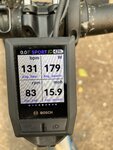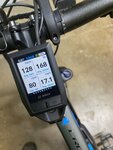The e-bike under exercising myth.
Each person’s thighs are made up of a unique combination of type I slow twitch (endurance) and type II fast twitch (fast cadence sprinting) muscle fibers. While it is true that you can do different training exercises to strengthen either fast or slow twitch fibers, you cannot actually change your genetic makeup. Which is why, over time, cyclists either consciously or unconsciously, find their most efficient cycling pace. Cyclists with more slow twitch fibers might settle into a cadence at 68-75 rpm with a 30-40% torque (pushing strength) while other cyclists with more fast twitch fibers find they can ride for miles at a 95 rpm with only 15% torque.
Luckily road bikes have many gears, and so a rider using a slower cadence in a higher gear can be riding just as fast as a rider with a faster cadence in a lower gear. Sprinters and swimmers are not so lucky.
A commonly perceived myth from those who don’t ride e-bikes is that you get less exercise because the electric motor is applying the torque for you. But those who ride e-bikes often refute that concept, commenting that the exercise effort is just the same - which is true.
No matter whether you ride assisted or not, you tend to ride at your individual best riding efficiency, as determined by your genetic makeup. You have trained yourself to ride at your own best mix of cadence and power. It often amazes me that I can ride 20 miles and my times will vary less than a minute, regardless of how I randomly hit the traffic lights. Your body learns how to ride most efficiently for the expended effort. Unless you deliberately change the way you ride, the exercise effort is the same. Calories burned are the same. Aerobic endurance and muscle strengthening is the same.
So, what do you gain from an e-bike then? In a word, speed. You go faster for the same effort exerted. If your ride is hilly and you find yourself bumping up into tour mode (no one admits using sport mode) you can do an unassisted one hour ride in 50 minutes with the same effort on an e-bike. If your ride is flat and you sit in ecco mode, your hour ride will take you 55 minutes with the same effort.
Apple’s new watch has some VO2 estimation, and the new Bosch Nyon display has power and energy displays that will allow quantitative verification of this concept, but enough anecdotal comments from the e-bike community should suffice for now.
Don’t fall for the myth propagated by those who haven’t converted. Its the same ride. But if you ride your e-bike somewhere instead of not riding at all, then your’e 100% better off, and you can’t do better than that.
Each person’s thighs are made up of a unique combination of type I slow twitch (endurance) and type II fast twitch (fast cadence sprinting) muscle fibers. While it is true that you can do different training exercises to strengthen either fast or slow twitch fibers, you cannot actually change your genetic makeup. Which is why, over time, cyclists either consciously or unconsciously, find their most efficient cycling pace. Cyclists with more slow twitch fibers might settle into a cadence at 68-75 rpm with a 30-40% torque (pushing strength) while other cyclists with more fast twitch fibers find they can ride for miles at a 95 rpm with only 15% torque.
Luckily road bikes have many gears, and so a rider using a slower cadence in a higher gear can be riding just as fast as a rider with a faster cadence in a lower gear. Sprinters and swimmers are not so lucky.
A commonly perceived myth from those who don’t ride e-bikes is that you get less exercise because the electric motor is applying the torque for you. But those who ride e-bikes often refute that concept, commenting that the exercise effort is just the same - which is true.
No matter whether you ride assisted or not, you tend to ride at your individual best riding efficiency, as determined by your genetic makeup. You have trained yourself to ride at your own best mix of cadence and power. It often amazes me that I can ride 20 miles and my times will vary less than a minute, regardless of how I randomly hit the traffic lights. Your body learns how to ride most efficiently for the expended effort. Unless you deliberately change the way you ride, the exercise effort is the same. Calories burned are the same. Aerobic endurance and muscle strengthening is the same.
So, what do you gain from an e-bike then? In a word, speed. You go faster for the same effort exerted. If your ride is hilly and you find yourself bumping up into tour mode (no one admits using sport mode) you can do an unassisted one hour ride in 50 minutes with the same effort on an e-bike. If your ride is flat and you sit in ecco mode, your hour ride will take you 55 minutes with the same effort.
Apple’s new watch has some VO2 estimation, and the new Bosch Nyon display has power and energy displays that will allow quantitative verification of this concept, but enough anecdotal comments from the e-bike community should suffice for now.
Don’t fall for the myth propagated by those who haven’t converted. Its the same ride. But if you ride your e-bike somewhere instead of not riding at all, then your’e 100% better off, and you can’t do better than that.

